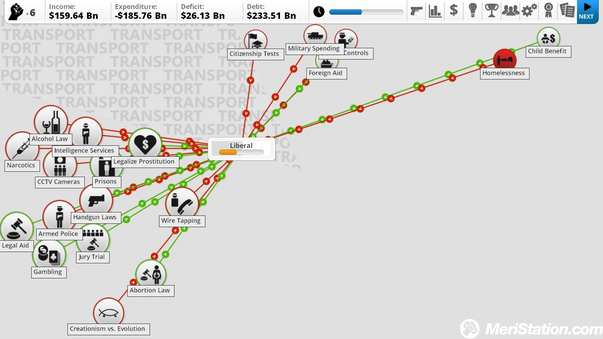The first Democracy came to PCin 2005, with a quite original and familiar approach. Under the premise of taking the role of President – or Prime Minister – of a nation, the simulator placed us at the helm of a government and invited us to face the challenges of everyday life.
The proposal was quite successful, and in 2007 a second installment was launched that presented a slight difference: Instead of using real countries, their names were fictitious. Although many may think that politics is not a topic of interest to young people today,
and perhaps not to those who spend much of their time with video games, the two titles accumulated an outstanding recognition to come from a independent company. In fact, its relevance went beyond the limits of electronic entertainment, to become a tool used in many
North American schools in order to explain to students some aspects of national politics. Now, 6 years after its latest version,Democracy 3 comes to our teams trying to repeat formula … at a juncture where many would like to have in their hands the virtual power that we are granted in this videogame.
Democracy 3 allows us to choose between 6 nations: United States, Canada, Australia, United Kingdom, France or Germany . Each of them starts from a different initial situation, and has different political characteristics. The years of mandate vary from one to another, as well as the maximum time that the same leader can occupy the maximum position of the State.
These parameters can be modified from the screen of introduction to the game, where we can also change the names of the two main political parties -yes, it will always be a bipartisan system- or the occurrence of catastrophes in the national territory. Once these terms have been chosen,
Democracy 3 will place us at the head of the newly elected government, with a whole mandate ahead to fulfill a single objective: To make the necessary decisions so that the opinion of the voters is satisfactory, and can be reelected in the following elections.
A task that is much more complicated than we could imagine, and that will force us to deal with all kinds of events and events in which each decision we make can affect us positively or negatively. Because it never rains to everyone’s taste.
Being a simulation game, Democracy 3 bases its mechanics on the management of resources. In the specific case that concerns us, these are the 4 important aspects present throughout the game: Political Power, Income, Expenses and Debt .
In turn, there are 6 main variables to consider for the development of our nation: Growth, Health, Education, Unemployment, Crime and Poverty. We will have to control these 10 elements if we want to succeed in leading the government, but it is a more complicated task than it seems at first sight. Initially, our real capacity resides in the Political Power.
This element, which is obtained each turn, is what we must spend to carry out any action in the game: Introduce a new policy, modify an existing one or cancel it, remove a minister from office or reorganize the entire cabinet. At the beginning of a new phase –
corresponding to a quarter- we will receive Political Power through our ministers, in a lesser or greater amount depending on their loyalty. In this way, an unfair minister will prevent us from carrying out important actions,
The other elements, both economic and state of the population, are variables that in turn depend on other variables … which may be affected by other variables. No aspect is really simple, since its state will depend on the state of many other elements
. For example, growth will depend on income through different taxes … which may depend on the performance of some policies and business productivity, which in turn is affected by working conditions, health, education or technological level in our nation.
This translates into a butterfly effect that covers practically all the elements of the country, in which each small decision is spread over a network of variables to end up affecting aspects that we might not have taken into account.

